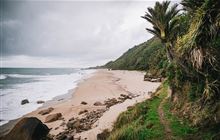Kahurangi Marine Reserve
Located in the West Coast region
|
Introduction
Kahurangi Marine Reserve lies off the far northwest of the South Island. Walkers on the famous Heaphy Track in Kahurangi National Park can enjoy a stroll along its southern reach.The marine reserve was established in 2014 and is 8418 hectares.
There is no road access to the marine reserve. Visitors on the Heaphy Track can access the southern half of the marine reserve from Heaphy Bluff to Crayfish Point.
Visitors should be well prepared with food, water, warm clothing and wet weather gear. You should tell a responsible person where you are going and how long you expect to be away.
You must remain at least 20 m from seals – find out more about sharing our coasts with marine mammals.
Stones (no more than 256 mm in intermediate diameter), shells, driftwood, sand and gravel can be collected by hand recreationally - but only as much as you can carry in one trip and with minimal disturbance to the site.
Pounamu can also be collected but only by members of Ngāi Tahu Whanui, or with the permission of Te Rūnanga o Ngāi Tahu.
Nearby Heaphy Track is one of New Zealand’s Great Walks and requires huts and campsites to be booked in advanced. Camping is not allowed within 200m of the track.
Kahurangi Marine Reserve protects the marine environment along 16 km of coastline and out to 5 km offshore between Wekakura Point and Crayfish Point.
The north of the reserve is a remote wilderness visited more by seals than humans. At 84 km2, it is one of the largest marine reserves in mainland New Zealand.
The coastline is a mixture of wild, honey coloured sandy beaches broken by boulders and reefs, bordering the coastal nikau forest of Kahurangi National Park. The marine reserve and national park combine to protect a full sequence of natural landscapes from the mountains to the ocean.
Driftwood adds a sculptural quality to the beaches, and supports small communities of animals such as earwigs, sandhoppers and spiders.
Rocky reefs and seastacks reach out from the boulder shores, supporting encrusting animals, invertebrates and inshore fish which thrive in the murky, churning water of this windward coast.
Fur seals/Kekeno often visit and rest at the Wekakura Point colony in the north of the reserve. It is also home to dozens of Hector’s dolphins.
The reserve reaches to depths of about 50 m. A seabed of mud and sand provides habitat for burrowing shellfish and coastal fish such as flounder, gurnard, snapper and sharks.
This reserve was created in 2014 to connect the protection of the National Park through to the ocean.
Contacts
| Paparoa National Park Visitor Centre | |
|---|---|
| Phone | +64 3 731 1895 |
| paparoavc@doc.govt.nz | |
| Address | 4294 Coast Road Punakaiki RD 1 Runanga 7873 |
| Hours | Visitor centre hours and services |




